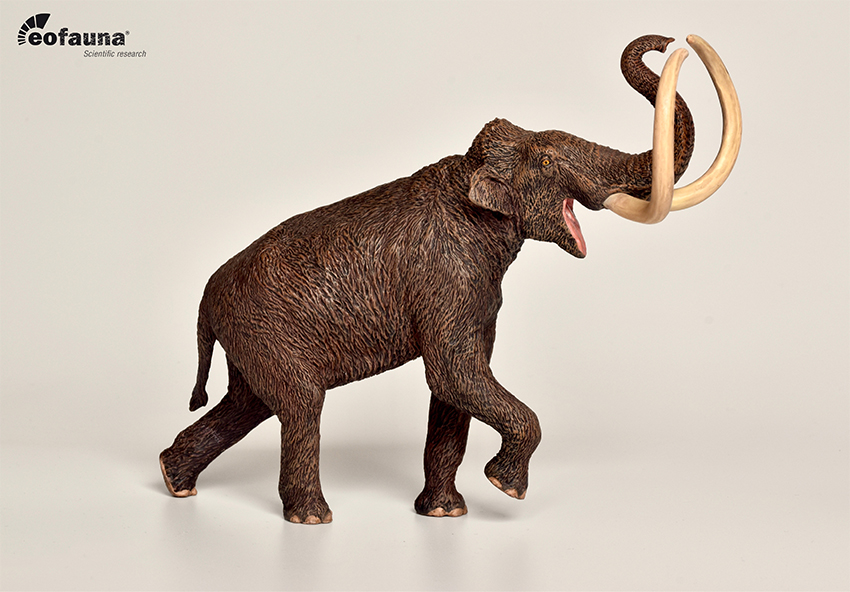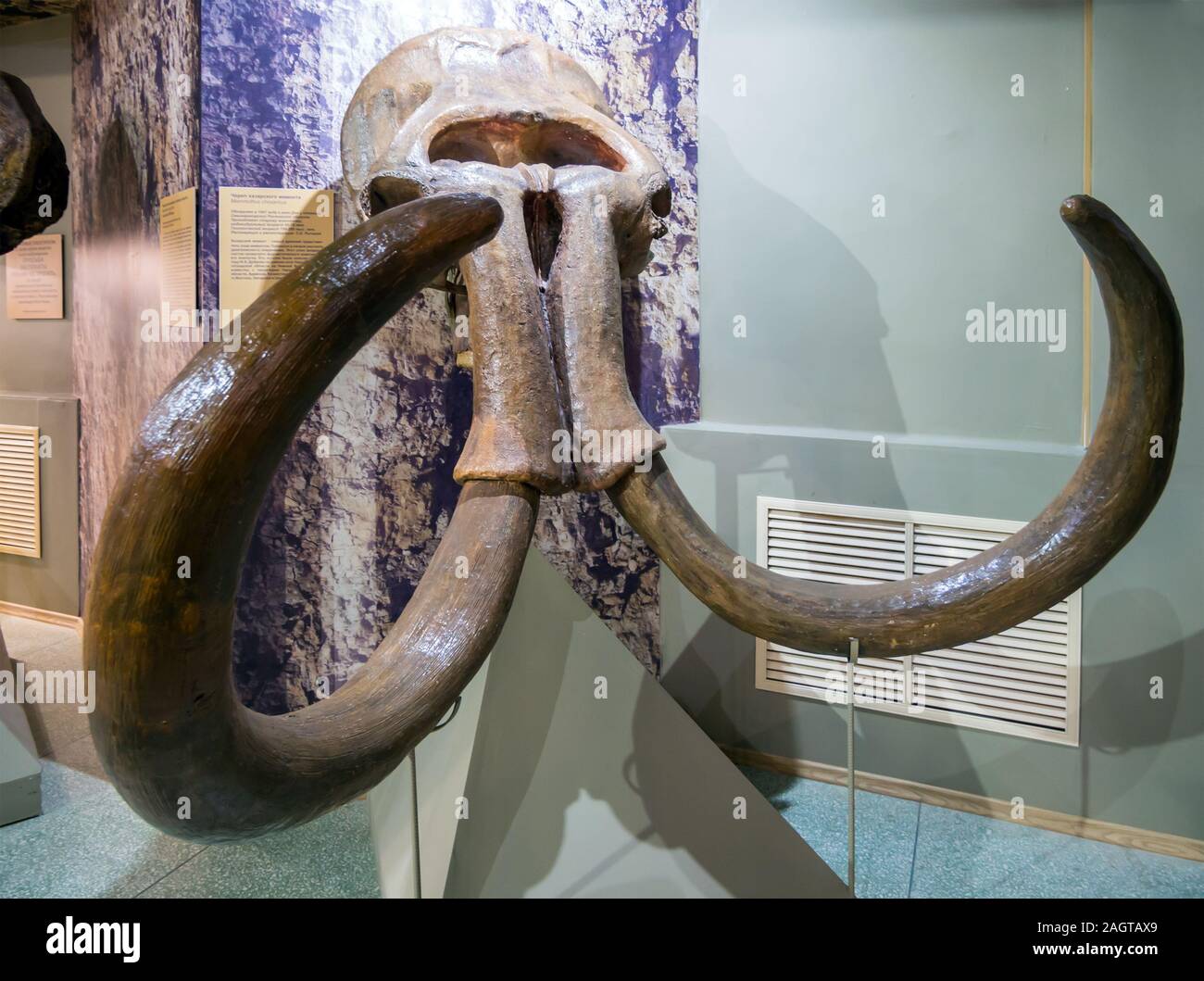Post by Infinity Blade on Jul 11, 2020 8:46:23 GMT 5
Steppe Mammoth: Mammuthus trogontherii

Life restoration of M. trogontherii in the form of a three-dimensional figure. Created by EoFauna->
Temporal range: Quaternary; Early to Middle Pleistocene (Calabrian to Chibanian; 1.7-0.2 Ma[1][2], possible Late Pleistocene records dating to ~33-24 ka[3])
Scientific classification:
Life
Domain: Eukaryota
(unranked): Unikonta
(unranked): Opisthokonta
(unranked): Holozoa
(unranked): Filozoa
Kingdom: Animalia
Subkingdom: Eumetazoa
(unranked): Bilateria
Superphylum: Deuterostomia
Phylum: Chordata
Infraphylum: Gnathostomata
Clade: Eugnathostomata
Clade: Teleostomi
Clade: Tetrapoda
Clade: Reptiliomorpha
Clade: Amniota
Clade: Synapsida
Clade: Eupelycosauria
Clade: Sphenacodontia
Clade: Sphenacodontoidea
Order: Therapsida
Clade: Cynodontia
Clade: Prozostrodontia
Clade: Mammaliaformes
Class: Mammalia
Legion: Cladotheria
Sublegion: Zatheria
Infralegion: Tribosphenida
Subclass: Theria
Clade: Eutheria
Infraclass: Placentalia
Subcohort: Exafroplacentalia
Magnorder: Atlantogenata
Superorder: Afrotheria
Clade: Paenungulata
Order: Proboscidea
Suborder: Elephantiformes
Clade: Elephantimorpha
Clade: Elephantida
Superfamily: Elephantoidea
Family: Elephantidae
Tribe: Elephantini
Genus: †Mammuthus
Species: †M. trogontherii
The steppe mammoth (Mammuthus trogontherii) is a species of mammoth that lived in Eurasia from the Early to Middle Pleistocene.
Evolution:
Fossils referable to M. trogontherii date back to 1.7 million years ago in northeast China, and 1.2-0.8 million years ago in northeast Siberia. It evolved from the earlier species M. meridionalis[1][2], becoming more tolerant to colder and more open habitats.[2] Between this time and ~600,000 years ago, gene (and/or individual) flow occurred westward to European M. meridionalis. This eventually led M. trogontherii to supplant M. meridionalis.[2]
M. trogontherii itself seems to have dispersed into North America early on (between 2-1.5 million years ago), eventually giving rise to M. columbi (the Columbian mammoth). M. primigenius (the woolly mammoth) also evolved from M. trogontherii in Beringia, eventually spreading to Europe and North America.[1] The woolly mammoth eventually replaced the steppe mammoth ~200,000 years ago[2], although there are some remains suggesting steppe mammoths survived into the Late Pleistocene.[3]
Description and biology:
Adult bull steppe mammoths have been calculated to weigh between 9.6-12.7 tonnes on average, with a typical shoulder height of 380-420 cm.[4] As in other mammoths, the tusks of males, especially those of respectable age, had large diameters and twisted spirally.[5]

The curved, spiraling tusks of M. trogontherii. Photo taken in the Azov Historical Archeological and Paleontological Museum->
M. trogontherii had higher tooth crowns than its ancestor, M. meridionalis, as an adaptation to grazing.[5] But, at least in the later years of its existence, it still exhibited rather variable mixed feeding, based on dental microwear patterns.[6][7]
References:
[1] Lister, A. M., & Sher, A. V. (2015). Evolution and dispersal of mammoths across the Northern Hemisphere. Science, 350(6262), 805-809.
[2] Lister, A. M., Sher, A. V., van Essen, H., & Wei, G. (2005). The pattern and process of mammoth evolution in Eurasia. Quaternary International, 126, 49-64.
[3] Wei, G., Hu, S., Yu, K., Hou, Y., Li, X., Jin, C., ... & Wang, W. (2010). New materials of the steppe mammoth, Mammuthus trogontherii, with discussion on the origin and evolutionary patterns of mammoths. Science China Earth Sciences, 53(7), 956-963.
[4] Larramendi, A. (2015). Shoulder height, body mass, and shape of proboscideans. Acta Palaeontologica Polonica, 61(3), 537-574.
[5] Mol, D., & Lacombat, F. (2009). Mammuthus trogontherii (Pohlig, 1885), the steppe mammoth of Nolhac. Preliminary report of a left and right upper M3, excavated at the ancient maar of Nolhac, Haute-Loire, Auvergne, France. Quaternaire. Revue de l'Association française pour l'étude du Quaternaire, 20(4), 569-574.
[6] Rivals, F., Semprebon, G., & Lister, A. (2012). An examination of dietary diversity patterns in Pleistocene proboscideans (Mammuthus, Palaeoloxodon, and Mammut) from Europe and North America as revealed by dental microwear. Quaternary International, 255, 188-195.
[7] Haiduc, B. S., Răţoi, B. G., & Semprebon, G. M. (2018). Dietary reconstruction of Plio-Pleistocene proboscideans from the Carpathian Basin of Romania using enamel microwear. Quaternary International, 467, 222-229.

Life restoration of M. trogontherii in the form of a three-dimensional figure. Created by EoFauna->
Temporal range: Quaternary; Early to Middle Pleistocene (Calabrian to Chibanian; 1.7-0.2 Ma[1][2], possible Late Pleistocene records dating to ~33-24 ka[3])
Scientific classification:
Life
Domain: Eukaryota
(unranked): Unikonta
(unranked): Opisthokonta
(unranked): Holozoa
(unranked): Filozoa
Kingdom: Animalia
Subkingdom: Eumetazoa
(unranked): Bilateria
Superphylum: Deuterostomia
Phylum: Chordata
Infraphylum: Gnathostomata
Clade: Eugnathostomata
Clade: Teleostomi
Clade: Tetrapoda
Clade: Reptiliomorpha
Clade: Amniota
Clade: Synapsida
Clade: Eupelycosauria
Clade: Sphenacodontia
Clade: Sphenacodontoidea
Order: Therapsida
Clade: Cynodontia
Clade: Prozostrodontia
Clade: Mammaliaformes
Class: Mammalia
Legion: Cladotheria
Sublegion: Zatheria
Infralegion: Tribosphenida
Subclass: Theria
Clade: Eutheria
Infraclass: Placentalia
Subcohort: Exafroplacentalia
Magnorder: Atlantogenata
Superorder: Afrotheria
Clade: Paenungulata
Order: Proboscidea
Suborder: Elephantiformes
Clade: Elephantimorpha
Clade: Elephantida
Superfamily: Elephantoidea
Family: Elephantidae
Tribe: Elephantini
Genus: †Mammuthus
Species: †M. trogontherii
The steppe mammoth (Mammuthus trogontherii) is a species of mammoth that lived in Eurasia from the Early to Middle Pleistocene.
Evolution:
Fossils referable to M. trogontherii date back to 1.7 million years ago in northeast China, and 1.2-0.8 million years ago in northeast Siberia. It evolved from the earlier species M. meridionalis[1][2], becoming more tolerant to colder and more open habitats.[2] Between this time and ~600,000 years ago, gene (and/or individual) flow occurred westward to European M. meridionalis. This eventually led M. trogontherii to supplant M. meridionalis.[2]
M. trogontherii itself seems to have dispersed into North America early on (between 2-1.5 million years ago), eventually giving rise to M. columbi (the Columbian mammoth). M. primigenius (the woolly mammoth) also evolved from M. trogontherii in Beringia, eventually spreading to Europe and North America.[1] The woolly mammoth eventually replaced the steppe mammoth ~200,000 years ago[2], although there are some remains suggesting steppe mammoths survived into the Late Pleistocene.[3]
Description and biology:
Adult bull steppe mammoths have been calculated to weigh between 9.6-12.7 tonnes on average, with a typical shoulder height of 380-420 cm.[4] As in other mammoths, the tusks of males, especially those of respectable age, had large diameters and twisted spirally.[5]

The curved, spiraling tusks of M. trogontherii. Photo taken in the Azov Historical Archeological and Paleontological Museum->
M. trogontherii had higher tooth crowns than its ancestor, M. meridionalis, as an adaptation to grazing.[5] But, at least in the later years of its existence, it still exhibited rather variable mixed feeding, based on dental microwear patterns.[6][7]
References:
[1] Lister, A. M., & Sher, A. V. (2015). Evolution and dispersal of mammoths across the Northern Hemisphere. Science, 350(6262), 805-809.
[2] Lister, A. M., Sher, A. V., van Essen, H., & Wei, G. (2005). The pattern and process of mammoth evolution in Eurasia. Quaternary International, 126, 49-64.
[3] Wei, G., Hu, S., Yu, K., Hou, Y., Li, X., Jin, C., ... & Wang, W. (2010). New materials of the steppe mammoth, Mammuthus trogontherii, with discussion on the origin and evolutionary patterns of mammoths. Science China Earth Sciences, 53(7), 956-963.
[4] Larramendi, A. (2015). Shoulder height, body mass, and shape of proboscideans. Acta Palaeontologica Polonica, 61(3), 537-574.
[5] Mol, D., & Lacombat, F. (2009). Mammuthus trogontherii (Pohlig, 1885), the steppe mammoth of Nolhac. Preliminary report of a left and right upper M3, excavated at the ancient maar of Nolhac, Haute-Loire, Auvergne, France. Quaternaire. Revue de l'Association française pour l'étude du Quaternaire, 20(4), 569-574.
[6] Rivals, F., Semprebon, G., & Lister, A. (2012). An examination of dietary diversity patterns in Pleistocene proboscideans (Mammuthus, Palaeoloxodon, and Mammut) from Europe and North America as revealed by dental microwear. Quaternary International, 255, 188-195.
[7] Haiduc, B. S., Răţoi, B. G., & Semprebon, G. M. (2018). Dietary reconstruction of Plio-Pleistocene proboscideans from the Carpathian Basin of Romania using enamel microwear. Quaternary International, 467, 222-229.



